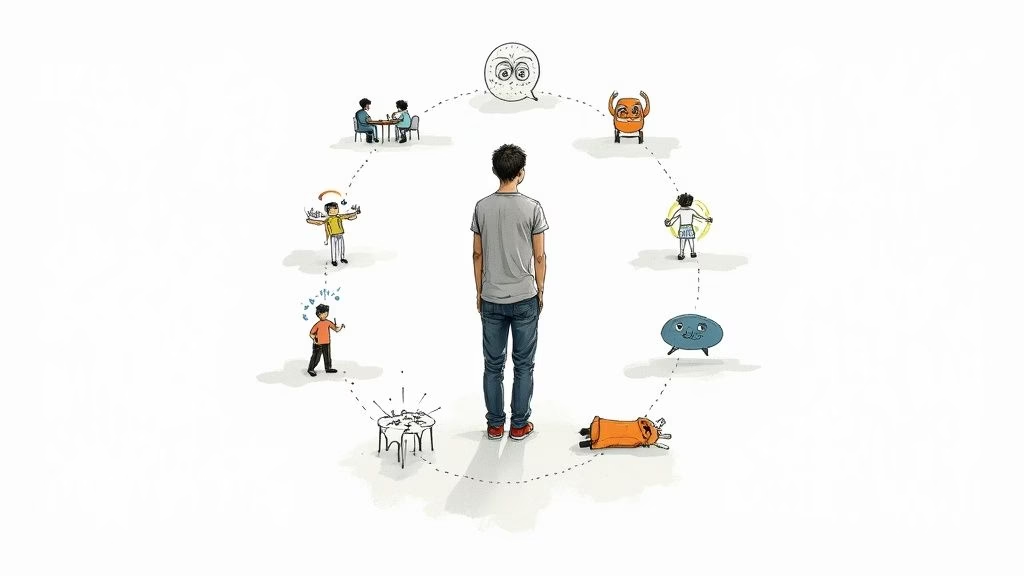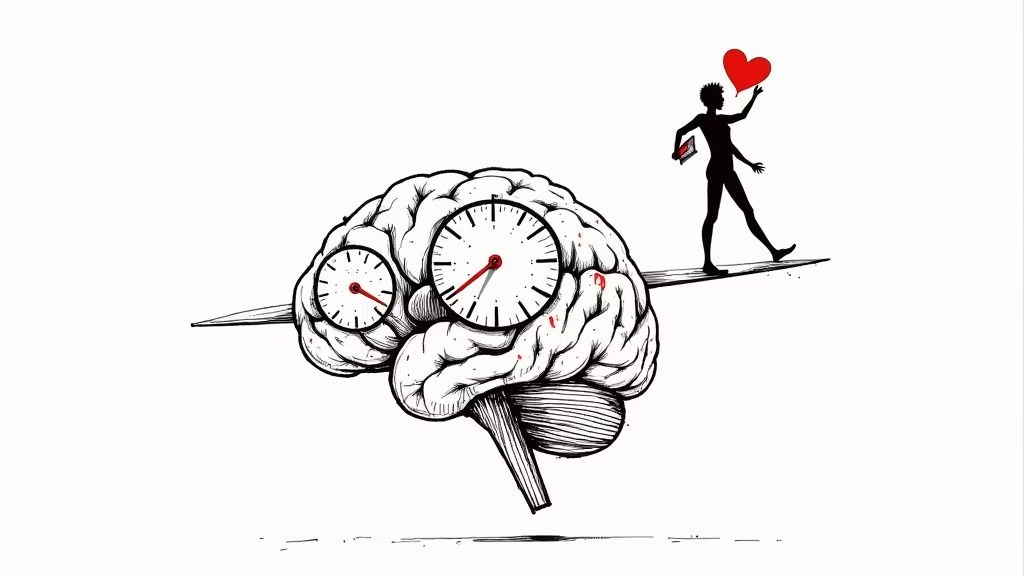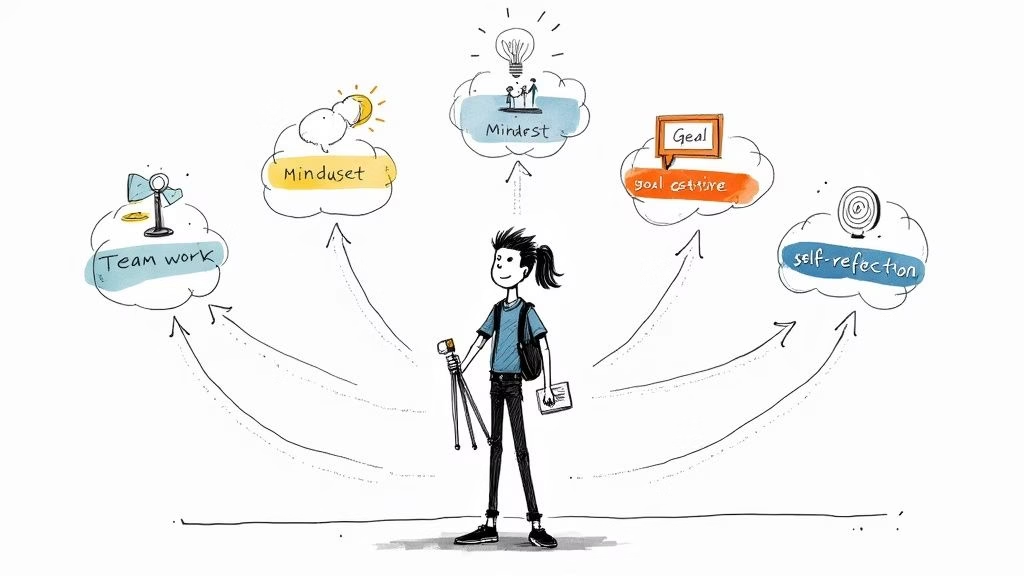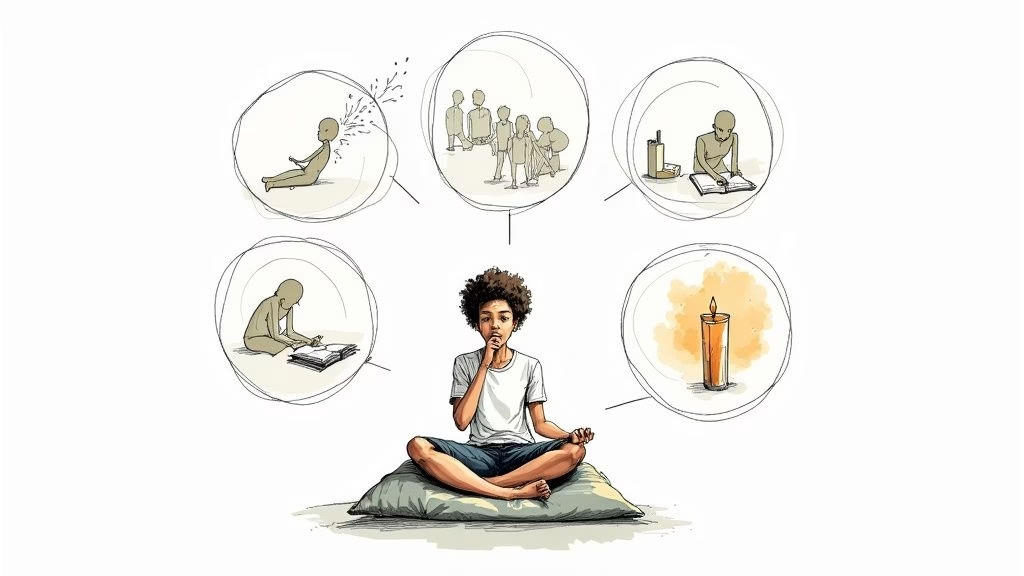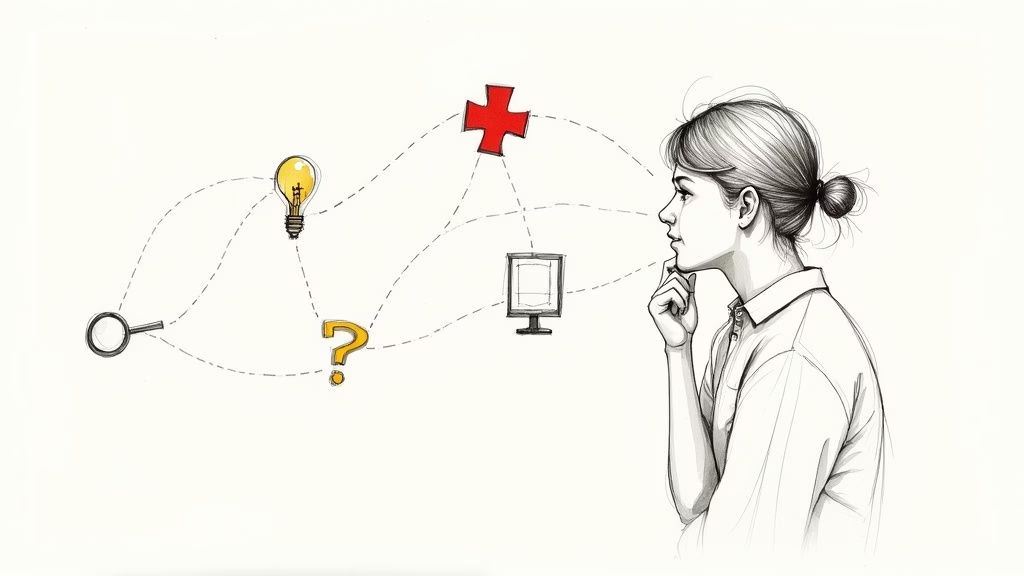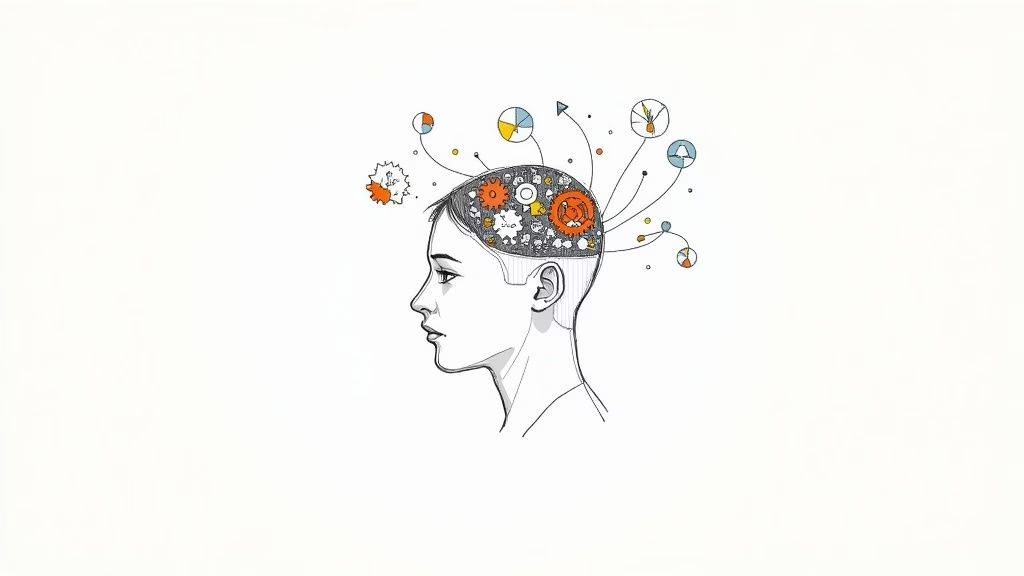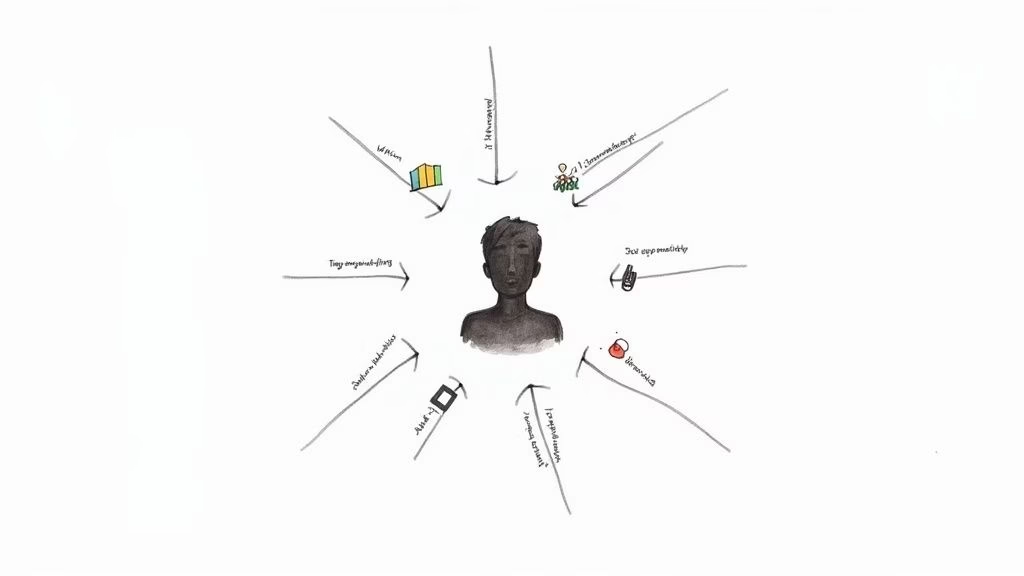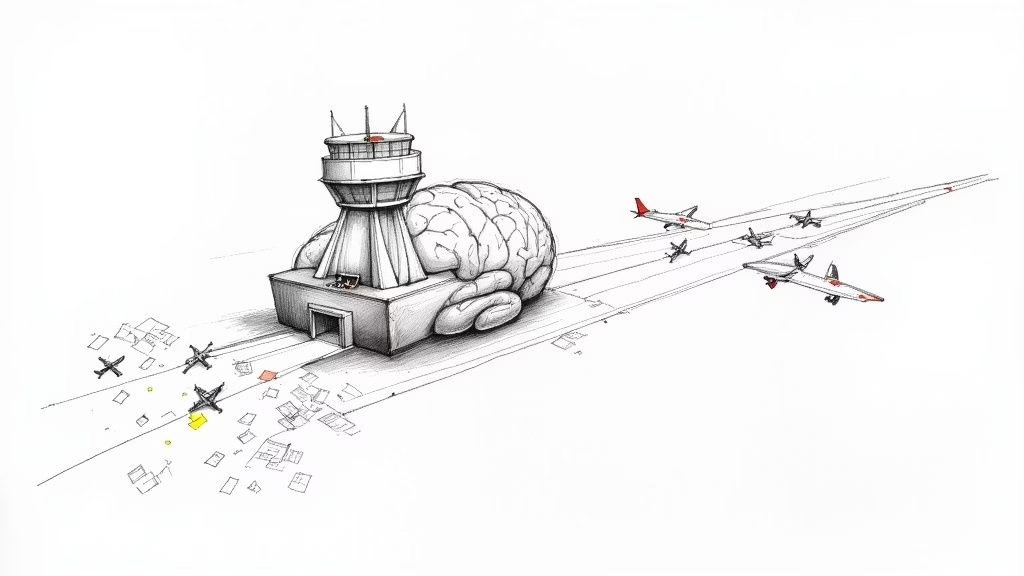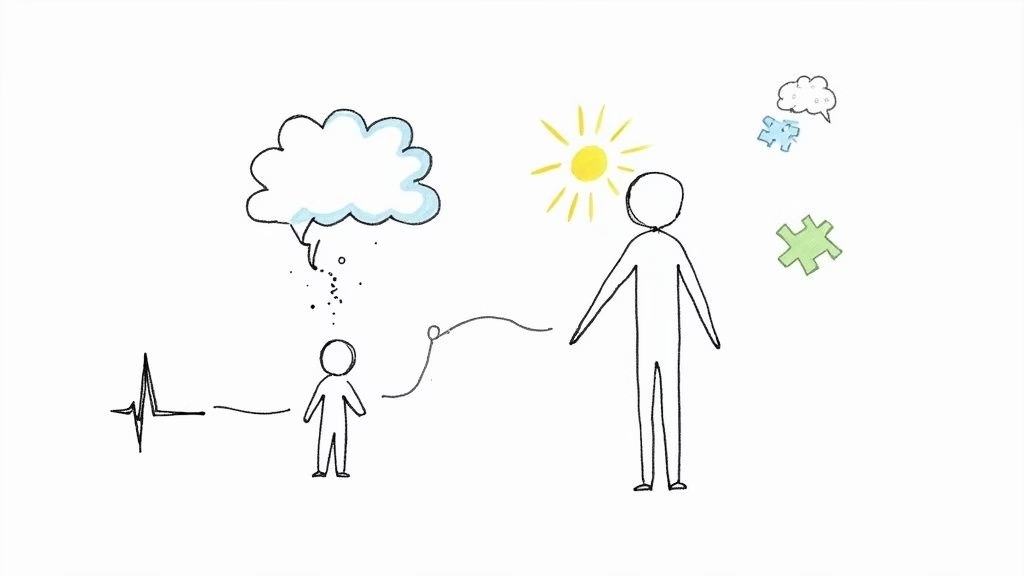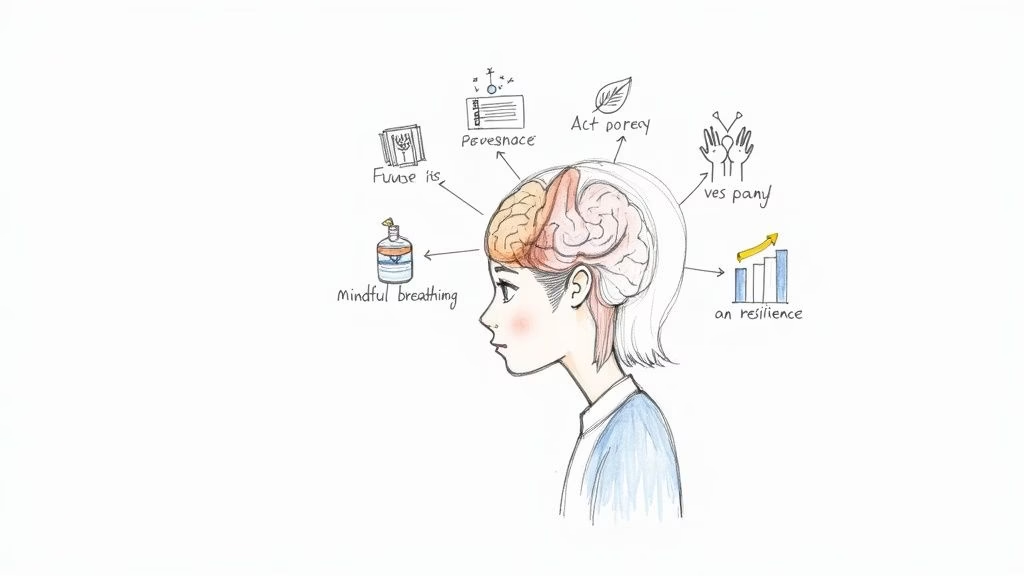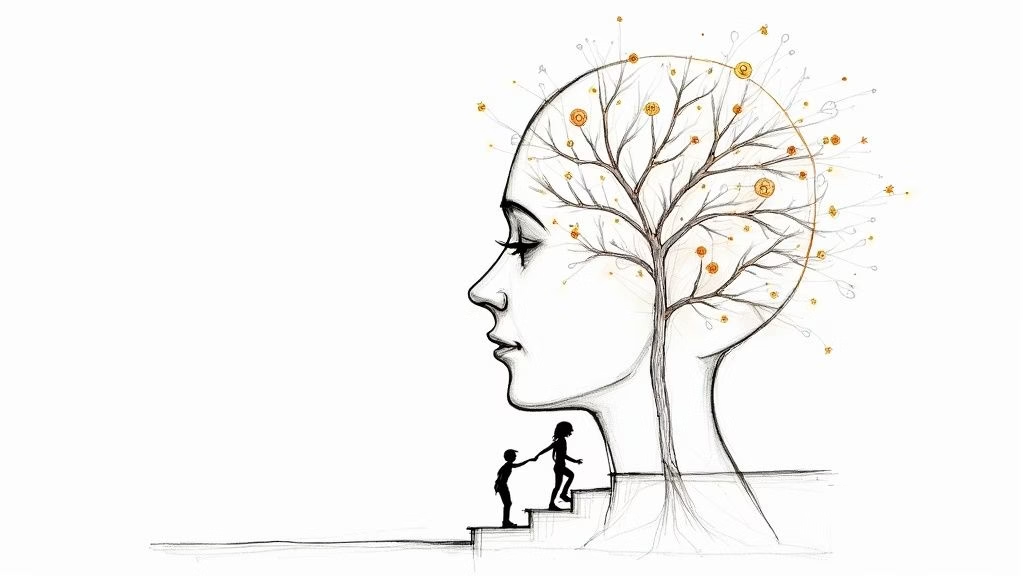In a world dominated by screens, genuine connection can feel like a lost art, especially for teenagers. Yet, strong communication skills are the bedrock of mental health, academic success, and future fulfillment. Many parents worry when they see their teens struggle with procrastination, social anxiety, or a lack of motivation, often without realizing these issues are deeply tied to communication. The ability to articulate thoughts and understand others is a crucial tool for navigating stress and building self-esteem, which directly impacts school performance and personal well-being.
This guide offers more than just a list; it provides a roadmap of specific, actionable communication activities for teenagers designed to build confidence, empathy, and resilience. We'll explore practical exercises that not only improve how teens talk and listen but also provide crucial parenting tips and connect you with resources for mental health, especially for teen boys who may be struggling in silence. As teens navigate a world increasingly blending digital and in-person interactions, it's also important to consider how to foster active participation, for instance, through effective strategies for student engagement in online learning. From structured debates to creative improv, these activities are tools to help your teen develop foundational skills, manage challenges, and ultimately thrive.
1. Active Listening Circles
Active Listening Circles are structured group exercises designed to teach one of the most fundamental yet underdeveloped skills in adolescents: listening to understand, not just to reply. In this activity, teenagers sit in a circle, and one person speaks at a time without interruption. After the speaker finishes, another participant paraphrases what they heard, confirming their understanding before the conversation moves forward. This simple structure powerfully enhances empathy, patience, and concentration.
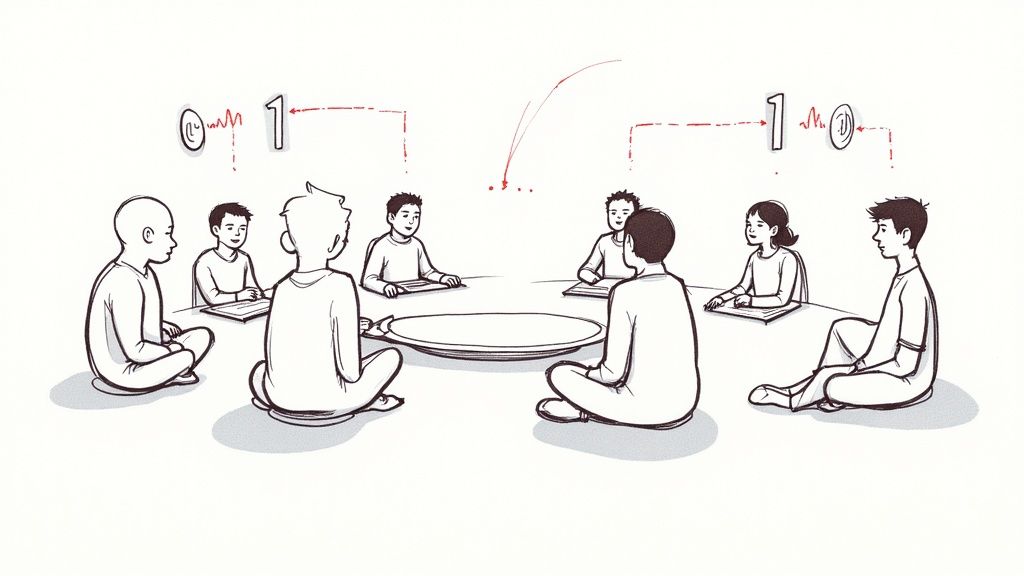
This method is especially effective for teens struggling with impulsivity or social anxiety, providing a safe and predictable environment to practice communication. It's a cornerstone of many peer counseling programs, restorative justice practices in schools, and leadership training in youth organizations. By creating a space where every voice is heard and validated, these circles help build trust and connection, which are crucial for teen mental health. For teen boys, in particular, who may be socialized to keep feelings private, this activity can be a breakthrough in learning to share and listen without judgment.
How to Implement Active Listening Circles
To run a successful circle, establish clear ground rules first: confidentiality, respect, and no cross-talk. Use a "talking piece," an object that grants the holder the exclusive right to speak. This prevents interruptions and encourages mindful participation.
- Parenting Tip: Model this at home. During dinner conversations, practice listening without immediately offering solutions or judgments. Let your teen finish their thought completely before you respond.
- Start with low-stakes topics: Begin with simple prompts like "Share one good thing that happened this week" to build comfort.
- Allow participants to pass: Never force a teenager to share. Giving them the option to pass builds psychological safety.
- Debrief: After the circle, discuss the experience. Ask questions like, "What did it feel like to be listened to without interruption?"
This practice directly addresses issues like procrastination and motivation by fostering a supportive peer environment. When teens feel heard and understood, they are more likely to feel secure and motivated to engage in challenging tasks, both academic and personal. The focused attention required can also be a form of mindfulness, helping to reduce stress and anxiety.
2. Debate and Public Speaking Clubs
Debate and Public Speaking Clubs provide teenagers with a formal framework to articulate arguments, think critically, and communicate persuasively. In these structured settings, participants research topics, construct logical arguments, and deliver speeches in a supportive yet challenging environment. This combination of preparation, performance, and peer feedback builds comprehensive communication skills, confidence, and resilience.

These clubs are especially beneficial for teens struggling with self-esteem or academic motivation, offering a platform to master complex information and present it authoritatively. Programs like TED-Ed Clubs and Model United Nations engage thousands of students globally, turning abstract concepts into tangible, exciting challenges. The structured nature of debate helps teens organize their thoughts, a crucial skill for overcoming procrastination on school assignments. By learning to advocate for a position, young men and women find their voice and build self-assurance.
How to Implement Debate and Public Speaking Clubs
To create an encouraging environment, the focus should be on growth, not just winning. A supportive culture where feedback is constructive is essential for building confidence and reducing anxiety associated with public performance.
- Parenting Tip: Encourage discussions about current events at home. Gently challenge your teen's viewpoint and ask them to provide evidence for their opinions. This builds their ability to form and defend an argument in a low-pressure setting.
- Start with low-stakes topics: Begin with fun, impromptu speaking exercises on subjects teenagers care about, like "Should schools have a four-day week?"
- Record and review: Use a smartphone to record speeches. Self-review is a powerful tool for improvement, helping teens identify habits they want to change.
- Practice anxiety management: Teach simple breathing and physical relaxation techniques to manage performance anxiety, a vital skill for mental health.
This type of structured practice is one of the most effective communication activities for teenagers because it directly enhances critical thinking and emotional regulation. When teens learn to articulate their ideas logically, they gain skills that translate directly to improved academic essays, class participation, and college interviews. Mastering these communication skills for teens can significantly boost their self-efficacy and motivation.
3. Improv Theater Games
Improv Theater Games are dynamic, unscripted activities that challenge teenagers to think on their feet, communicate with clarity, and collaborate creatively. Popular games like 'Yes, And…' or 'Freeze Tag' dismantle the fear of perfection and encourage spontaneous, risk-free communication. These exercises are powerful tools for teaching adaptability, active listening, and the crucial skill of building upon others' ideas instead of dismissing them.

This approach is highly effective for teens who are hesitant to speak up or those who overthink social interactions, offering a playful setting to practice being present. Improv is a staple in school drama clubs and youth leadership programs like those at The Second City. By fostering an environment where every contribution is valued and mistakes are celebrated as opportunities, these games build confidence and resilience, which are essential for teen mental health and motivation.
How to Implement Improv Theater Games
The key to successful improv is creating a supportive, high-energy, and judgment-free zone. The core principle is "Yes, And…," which means participants must accept what a scene partner has stated ("Yes") and then expand on that line of thinking ("And"). This creates a collaborative, not competitive, atmosphere.
- Parenting Tip: Use the "Yes, And…" principle in conversations about schoolwork or chores. If a teen expresses a challenge ("This math homework is impossible"), try responding with "Yes, it looks really tough, and what's one small step we could take to start?" This validates their feeling while gently moving toward a solution.
- Start with low-pressure warm-ups: Begin with simple games like 'One-Word Story' to get everyone comfortable and laughing.
- Create a "failure is awesome" culture: Frame mistakes as fun discoveries, which reduces performance anxiety and encourages participation.
- Debrief after games: Connect the experience back to real-life situations. Ask, "How can using 'Yes, And…' help when you disagree with a friend or parent?"
These activities directly combat procrastination and low motivation by reframing challenges as collaborative and fun. The quick thinking and teamwork required can break teens out of cycles of negative self-talk and isolation. For teenage boys, in particular, improv offers a healthy outlet for expression and a way to build supportive peer relationships outside of traditional competitive environments.
4. Digital Storytelling Projects
Digital Storytelling Projects merge classic narrative development with modern multimedia tools, empowering teenagers to express themselves through video, audio, images, and text. This activity involves crafting a personal script, recording narration, and editing media into a short, compelling digital presentation. It bridges the gap between traditional communication skills like creative writing and the digital literacy essential in today's world, offering a powerful platform for self-expression.
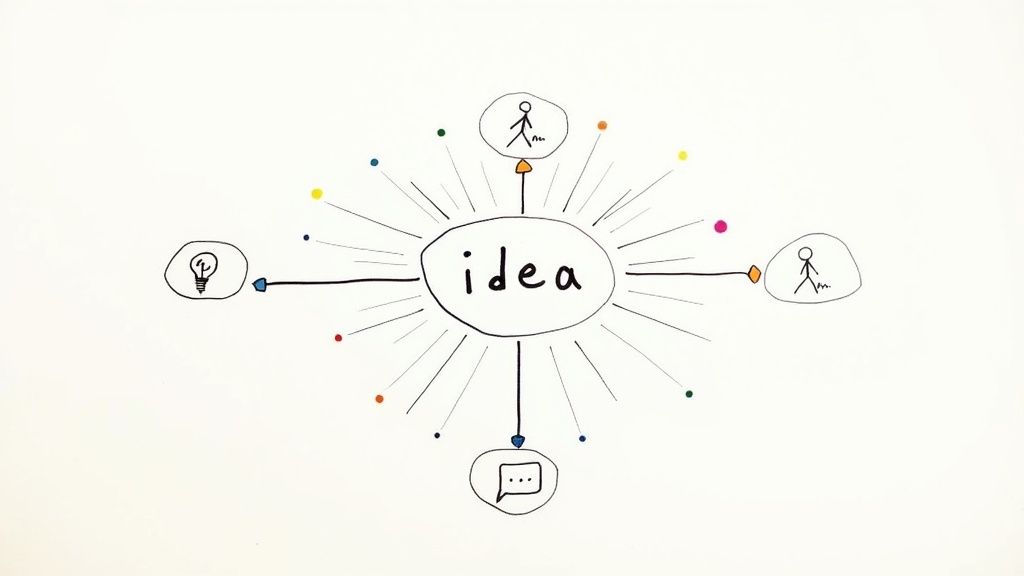
This method is particularly effective for teens who feel unheard or struggle to articulate their feelings verbally. Organizations like StoryCenter and the Adobe Youth Voices initiative have shown that this process helps build confidence, emotional intelligence, and technical skills simultaneously. For a young man struggling to find his voice, creating a digital story can provide a structured, less direct way to share his experiences, boosting his self-esteem and sense of agency.
How to Implement Digital Storytelling Projects
Success begins with focusing on the story itself, not just the technology. Provide a clear structure to guide the creative process and ensure the project remains manageable.
- Parenting Tip: Create a family digital story. Work together to document a family vacation or a significant event. This collaborative project models teamwork and shows that you value their digital skills.
- Focus on the narrative first: Before introducing any software, have teens brainstorm and write their story. Use templates for a simple beginning, middle, and end.
- Use accessible tools: Start with free, user-friendly software like iMovie, WeVideo, or Windows Video Editor to avoid a steep learning curve.
- Discuss digital citizenship: Before sharing projects, hold a discussion about online privacy, responsible sharing, and the permanence of digital content.
This practice directly addresses motivation and procrastination by providing a project-based learning experience with a tangible, shareable outcome. The act of shaping their personal narrative helps teens process emotions and build resilience, which are key components of mental health. Celebrating the final projects in a group setting creates a supportive environment that validates each participant's unique journey.
5. Role-Playing Scenarios
Role-Playing Scenarios are dynamic, interactive exercises where teenagers act out specific social situations to practice communication skills in a safe, controlled environment. Participants might rehearse difficult conversations, such as asking a teacher for help, resolving conflicts with friends, or navigating job interviews. This "rehearsal for life" allows them to experiment with different communication styles, build confidence, and receive immediate, constructive feedback without real-world consequences.
This method is highly effective for teens who feel anxious about social interactions or procrastinate on tasks requiring assertive communication. It is a cornerstone of cognitive behavioral therapy (CBT), social skills training for neurodiverse teens, and leadership programs. By safely exploring challenging scenarios, teens can reduce their fear of failure, which is a significant driver of procrastination and academic avoidance. It builds practical skills and the emotional resilience needed to face difficult conversations head-on.
How to Implement Role-Playing Scenarios
Success depends on creating a non-judgmental atmosphere where teens feel comfortable taking risks. Start by explaining that the goal is practice, not performance. Co-create scenarios with the teenagers to ensure the situations are relevant and meaningful to their lives.
- Parenting Tip: If your teen is avoiding a difficult conversation (e.g., talking to a teacher about a bad grade), offer to role-play it with them. Let them practice being both themselves and the teacher. This demystifies the interaction and builds their confidence.
- Start with low-stakes situations: Begin with easier scenarios, like ordering food at a restaurant or asking for directions, before moving to more emotionally charged topics.
- Use the 'freeze' technique: Pause the role-play at a critical moment to discuss different possible responses and their potential outcomes. This empowers teens to think critically.
- Incorporate role reversal: Have participants switch roles to build empathy and understand different perspectives, a crucial skill for conflict resolution.
This activity directly targets the roots of motivation issues by equipping teens with the confidence and tools to handle interpersonal challenges. When a young man, for example, feels capable of navigating a tough conversation with a coach or peer, he is less likely to avoid situations that require such skills. This sense of competence can reduce anxiety and boost self-esteem, creating a positive ripple effect on their engagement in school and personal life.
6. Collaborative Art and Mind Mapping
Collaborative art and mind mapping are powerful communication activities for teenagers that shift the focus from verbal to visual expression. These exercises require groups to create shared visual representations like murals, concept maps, or vision boards. Participants must negotiate ideas, make shared decisions, and translate abstract thoughts into concrete visual forms, fostering a different kind of dialogue.
This approach is highly effective for visual learners and teens who find purely verbal communication challenging or intimidating, including those processing complex emotions or trauma. It’s used in design thinking workshops, therapy settings, and community projects to build consensus and express identity. By externalizing thoughts visually, teens can organize complex information, overcome creative blocks, and see connections they might otherwise miss, which can be a key strategy in tackling academic procrastination.
How to Implement Collaborative Art and Mind Mapping
The goal is communication, not artistic perfection. Emphasize that every contribution has value. Provide a wide range of materials like large paper, sticky notes, markers, magazines, and even digital tools to encourage creativity.
- Parenting Tip: Use a mind map to tackle a complex family decision or plan a big school project with your teen. Visually organizing the steps and ideas can make a daunting task feel manageable and reduce procrastination.
- Use creative prompts: Start with questions like, "If our goal were a landscape, what would it look like?" or "Map out the steps to finish this project."
- Focus on the process: Encourage discussion and negotiation as the group decides on colors, shapes, and layouts. The dialogue during creation is as important as the final product.
- Hold a 'gallery walk': Have each group present their visual creation, explaining the meaning behind their choices. This final step bridges the visual communication back to verbal skills.
This technique helps develop vital social and emotional skills by making abstract concepts tangible. For young men who may be less inclined to verbalize their feelings, these visual communication activities for teenagers offer a constructive and less direct outlet for expression and connection. Learn more about how these and other social skills activities for teenagers can support development.
7. Podcast Creation Workshops
Podcast Creation Workshops guide teenagers through the process of developing, recording, editing, and publishing their own audio content. This hands-on activity teaches vital communication skills, such as scriptwriting, storytelling, conducting interviews, and conveying ideas clearly without visual cues. Participants learn to articulate their thoughts coherently and engage an audience, blending creative expression with technical proficiency in a medium popular with their generation.
This process is incredibly empowering, especially for teens who may feel unheard or struggle with traditional forms of self-expression. By creating their own show, they take ownership of their narrative, boosting self-esteem and providing a sense of purpose. Initiatives like NPR's Student Podcast Challenge and curricula from programs like Youth Radio have shown how podcasting can give young men and women a powerful platform to explore topics relevant to their lives, from mental health to social issues.
How to Implement Podcast Creation Workshops
To get started, focus on making the technology accessible and the creative process manageable. The goal is expression, not perfection.
- Parenting Tip: Be your teen's first interview guest. Show genuine interest in their project and offer to help them practice their interview skills. This support can be a huge motivator.
- Start with short formats: Encourage 5-10 minute episodes focused on a single topic to prevent teens from feeling overwhelmed.
- Use free tools: Begin with accessible software like Audacity or GarageBand, which are powerful enough for high-quality production.
- Focus on structure: Teach a simple episode structure (introduction, main content, conclusion) to help organize their thoughts and prevent rambling. Once teens have recorded their content, learning how to edit podcast audio for a professional sound is the next critical step to produce high-quality shows.
This activity directly combats procrastination by providing a project with a tangible, exciting outcome. The structured deadlines and collaborative nature of producing a podcast can motivate teens to manage their time effectively, develop research skills, and build confidence in their voice, translating to improved academic engagement and reduced anxiety.
8. Nonviolent Communication (NVC) Training
Nonviolent Communication (NVC) training equips teenagers with a powerful framework for expressing needs, navigating conflict, and setting boundaries without blame or criticism. Developed by psychologist Marshall Rosenberg, the NVC model focuses on four key components: observations, feelings, needs, and requests. This structured process helps teens articulate their experiences clearly and compassionately, transforming potentially explosive arguments into productive conversations.
This method is highly effective in environments like peer mediation programs, family therapy, and restorative justice circles in schools. For a teen struggling with motivation or procrastination, NVC offers a way to express feelings of being overwhelmed without resorting to anger or shutdown. It builds deep emotional intelligence, a crucial skill for personal development and academic success. You can learn more about emotional intelligence in adolescence on andrewpetrillolifecoaching.com.
How to Implement Nonviolent Communication (NVC) Training
Introducing NVC requires patience and practice. The goal is to make the four steps second nature, shifting communication from a reactive to a conscious process. Start by focusing on distinguishing objective observations from subjective evaluations.
- Parenting Tip: Practice NVC when addressing conflicts at home. Instead of saying, "You're so lazy for not doing the dishes," try, "When I see the dishes in the sink, I feel frustrated because I need help keeping the house clean. Would you be willing to do them now?"
- Build a feelings vocabulary: Use a feelings wheel or chart to help teens identify and name their emotions accurately, moving beyond simple terms like "mad" or "sad."
- Connect feelings to needs: Guide teens to understand that feelings are signals pointing to universal human needs, such as a need for respect, understanding, or autonomy.
- Start with self-empathy: Encourage teens, especially young men who may struggle to express vulnerability, to apply NVC to their own internal dialogue first. This builds self-compassion and reduces stress.
By mastering this communication activity, teenagers gain the tools to advocate for themselves respectfully, resolve conflicts constructively, and build healthier, more trusting relationships with family, friends, and teachers.
9. Fishbowl Discussions
Fishbowl Discussions are structured conversations where a small group of teens sits in an inner circle (the 'fishbowl') to discuss a topic, while a larger group observes from an outer circle. This dynamic format teaches teenagers to be both active participants and critical observers of communication. Observers analyze discussion patterns and effective techniques before rotating into the fishbowl, gaining a unique meta-awareness of turn-taking, inclusive participation, and constructive dialogue.
This method is highly effective in academic settings, such as high school English classes analyzing literature or social studies classes debating ethical dilemmas. It's also a powerful tool in leadership and conflict resolution training, helping teens dissect group decision-making and negotiation dynamics. By separating the acts of speaking and observing, the Fishbowl format reduces the pressure to perform, making it one of the most insightful communication activities for teenagers to build confidence and analytical skills.
How to Implement Fishbowl Discussions
Success depends on clear structure and a focus on both content and process. Begin by establishing the topic and providing the outer circle with specific observation guidelines, such as tracking how often people build on others' ideas or ask clarifying questions.
- Parenting Tip: Adapt this for family meetings. Let two family members discuss a topic while others listen silently, then switch. This ensures everyone gets a chance to speak and be heard without interruption.
- Start with relevant topics: Choose subjects that genuinely interest teens, like social media's impact or school policies, to ensure engagement.
- Use the "open chair" variation: Leave one chair empty in the inner circle, allowing an observer to temporarily join when they have a crucial point to add.
- Debrief the process: After a round, focus the discussion first on the how of the conversation before diving into the what. Ask observers, "What communication patterns did you notice?"
This activity directly challenges procrastination by making learning interactive and engaging. The focused observation can also serve as a mindfulness practice, helping teens manage the anxiety of public speaking by first allowing them to analyze it from a safe distance. This builds a foundation of confidence and strategic thinking applicable to academic presentations and future professional settings.
Communication Activities Comparison Matrix
| Activity | Implementation Complexity | Resource Requirements | Expected Outcomes | Ideal Use Cases | Key Advantages |
|---|---|---|---|---|---|
| Active Listening Circles | Moderate; requires skilled facilitation | Minimal; talking piece or simple setup | Empathy, patience, improved listening | Building trust in small to mid-sized teen groups | Develops emotional intelligence; supportive environment |
| Debate and Public Speaking Clubs | High; formal formats and prep needed | Moderate to high; research materials, travel | Public speaking confidence, critical thinking | Competitive, leadership, academic skills | Boosts argumentation skills; valued in academia and leadership |
| Improv Theater Games | Low to moderate; needs clear facilitation | Minimal; open space | Quick thinking, adaptability, teamwork | Team building, social confidence, mixed-ability groups | Encourages creativity; fun and engaging |
| Digital Storytelling Projects | Moderate to high; tech skill and time-intensive | Technology access (devices, software) | Digital literacy, storytelling, creative expression | Tech-inclined teens, identity exploration | Combines digital and traditional communication; portfolio development |
| Role-Playing Scenarios | Moderate; scenario prep and facilitation | Minimal to moderate; scripts or prompts | Social skills, confidence, empathy | Practicing specific challenging interactions | Safe environment for real-world skill rehearsal; perspective-taking |
| Collaborative Art and Mind Mapping | Low to moderate; materials and facilitation needed | Art supplies or digital tools | Visual communication, creative thinking | Visual learners, complex concepts, team building | Inclusive for verbal-challenged teens; promotes consensus |
| Podcast Creation Workshops | Moderate to high; tech and content planning | Recording equipment, editing software | Verbal articulation, interview skills | Media/journalism interested teens, sustained projects | Develops voice confidence; technical media skills |
| Nonviolent Communication (NVC) Training | Moderate; structured curriculum and practice required | Minimal; training materials | Conflict resolution, emotional literacy | Conflict-prone groups, family and peer relations | Evidence-based, reduces defensiveness, builds empathy |
| Fishbowl Discussions | Moderate; requires skilled facilitation and structure | Minimal; seating arrangement | Communication meta-awareness, discussion skills | Complex topic exploration, discussion skill-building | Combines participation and observation; encourages quieter voices |
Putting Skills into Practice: Resources and Next Steps
The journey from learning a new skill to mastering it requires consistent, intentional effort. The communication activities for teenagers detailed in this article, from Active Listening Circles to Fishbowl Discussions, are more than just exercises; they are practical tools for building confidence, empathy, and resilience. By engaging in these practices, teens don't just learn to speak more clearly, they learn to listen more deeply, understand different perspectives, and advocate for themselves with integrity. This foundation is crucial for navigating academic pressures, building healthy relationships, and preparing for the complexities of college and career paths.
The true value of these skills emerges when they are applied to real-world challenges. For many teenagers, especially those struggling with procrastination or motivation, the ability to articulate their needs and anxieties is the first step toward overcoming academic hurdles. Strong communication helps them seek help from teachers, collaborate effectively on group projects, and manage the stress that often accompanies high school life.
Connecting Communication to Mental Wellness
Effective communication is intrinsically linked to mental health. The ability to express emotions constructively and seek support is a protective factor against stress and anxiety. When teens feel unheard or misunderstood, it can lead to feelings of isolation. The activities in this article are designed to build the self-awareness and emotional vocabulary needed for better mental well-being.
Key Takeaway: Communication is not just about exchanging information; it's about building connection and understanding, which are fundamental to a teen’s mental and emotional health.
For parents and teens seeking further support, several resources can provide guidance and a safe space for growth.
- Mental Health Guides: Reputable organizations like the National Institute of Mental Health (NIMH) and The Jed Foundation offer extensive, evidence-based resources tailored specifically for teenagers and young adults.
- A Simple Meditation Guide for Teens: Self-regulation is a cornerstone of effective communication. A brief meditation practice can build this skill.
- Find a quiet spot where you can sit comfortably without distractions.
- Sit upright, close your eyes, and place your hands in a relaxed position.
- Focus on your breath for 3-5 minutes. Notice the sensation of air entering and leaving your body.
- Gently guide your focus back when your mind wanders, without judgment. This simple act trains your attention and builds mindfulness.
- Resources for Young Men: For teen boys navigating the pressures of modern masculinity, dedicated spaces are invaluable. Organizations like The ManKind Project and Evryman host men's groups and programs that encourage emotional expression and healthy community, providing powerful support systems.
By integrating these communication activities into their lives, teenagers are not just preparing for a test or a presentation; they are building a versatile skill set that will serve them for a lifetime. They are learning to connect, to lead, and to navigate their world with greater confidence and purpose.
If your teen is struggling to translate these concepts into action and needs personalized guidance to build motivation and confidence, a dedicated coach can make all the difference. At Andrew Petrillo Life Coaching, we specialize in helping teenagers and young adults implement these exact skills to overcome academic challenges and thrive in their transition to college and beyond. Schedule a complimentary discovery call at Andrew Petrillo Life Coaching to learn how a tailored strategy can unlock your teen’s full potential.


